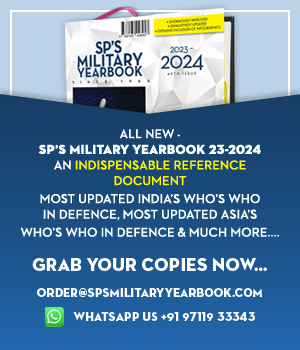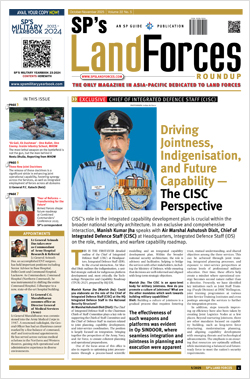INDIAN ARMED FORCES CHIEFS ON OUR RELENTLESS AND FOCUSED PUBLISHING EFFORTS
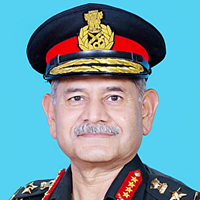
The insightful articles, inspiring narrations and analytical perspectives presented by the Editorial Team, establish an alluring connect with the reader. My compliments and best wishes to SP Guide Publications.

"Over the past 60 years, the growth of SP Guide Publications has mirrored the rising stature of Indian Navy. Its well-researched and informative magazines on Defence and Aerospace sector have served to shape an educated opinion of our military personnel, policy makers and the public alike. I wish SP's Publication team continued success, fair winds and following seas in all future endeavour!"

Since, its inception in 1964, SP Guide Publications has consistently demonstrated commitment to high-quality journalism in the aerospace and defence sectors, earning a well-deserved reputation as Asia's largest media house in this domain. I wish SP Guide Publications continued success in its pursuit of excellence.
- All about HAMMER Smart Precision Guided Weapon in India — “BEL-Safran Collaboration”
- US to sell $93 million precision artillery, Javelin and Excalibur projectiles to India
- US to sell $93 million precision artillery, Javelin and Excalibur projectiles to India
- India, Germany deepen defence ties as High Defence Committee charts ambitious plan
- True strategic autonomy will come only when our code is as indigenous as our hardware: Rajnath Singh
- India-Israel Joint Working Group Meeting on defence cooperation to boost technology sharing and co-development
- G20 Summit: A Sign of Global Fracture
Driving Jointness, Indigenisation, and Future Capability
CISC's role in the integrated capability development plan is crucial within the broader national security architecture. In an exclusive and comprehensive interaction, Manish Kumar Jha speaks with Air Marshal Ashutosh Dixit, Chief of Integrated Defence Staff (CISC) at Headquarters, Integrated Defence Staff (IDS) on the role, mandates, and warfare capability roadmap.
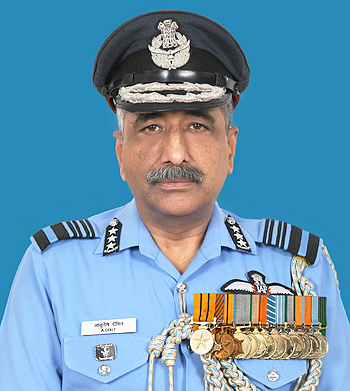
This is the first-ever detailed outline of the Chief of Integrated Defence Staff (CISC) at Headquarters, Integrated Defence Staff (IDS). In the crucial interaction, Air Marshal Dixit outlines the indigenisation, a unified strategic outlook for indigenous platform development and, most critically, the Technology Perspective and Capability Roadmap (TPCR) 2025, prepared by HQ IDS.
Manish Kumar Jha (Manish Jha): Could you elaborate on the role of the Chief of Integrated Defence Staff (CISC) at the HQ Integrated Defence Staff in the National Security Structure?
Air Marshal Ashutosh Dixit (Dixit): The Chief of Integrated Defence Staff to the Chairman Chiefs of Staff Committee plays a key role in supporting the Chiefs of Staff Committee and the Chief of Defence Staff in matters related to joint planning, capability development, and inter-service coordination. The position is largely focused on integration, bringing together the perspectives of the Army, Navy, and Air Force, to ensure coherent planning and operational preparedness.
At HQ IDS and the Services, we are seized of the constantly evolving character of warfare and have adjusted our modernisation plans accordingly
One of the focus areas of this office is also in regards to optimising joint procurements through a process-based scientific modelling and an integrated capability development plan. Within the broader national security architecture, the role is advisory and facilitative, helping to bridge the services with other stakeholders, including the Ministry of Defence, while ensuring that decisions are well-informed and aligned with long-term strategic objectives.
Manish Jha: The CISC is an apex-level body for military Jointness. How do you promote a culture of Jointness? What are the other mandates which work towards building military capabilities?
Dixit: Building a culture of jointness is a gradual process that requires fostering trust, mutual understanding, and shared objectives among the three services. This can be achieved through joint training, integrated planning processes, and exposure to inter-service perspectives at various levels of professional military education. Over time, these efforts help create a mindset where operational synergy becomes second nature rather than a directive. Presently, we have identified key initiatives such as Joint Staff Training (Purple Division) at DSSC Wellington, joint training programmes at various Joint Service Training Institutes and cross postings amongst the services to further the integration process.
The emphasis is on ensuring that resources are optimally utilised, while maintaining a balanced and future-ready force to meet the nation's security requirements
In addition, steps towards improving op efficiency have also been taken by creating Joint Logistics Nodes at a few places. Beyond nurturing Jointness, there are other mandates focused on capability building, such as long-term force structuring, modernisation planning, and aligning capability development with emerging threats and technological advancements. The emphasis is on ensuring that resources are optimally utilised, while maintaining a balanced and future-ready force to meet the nation's security requirements.
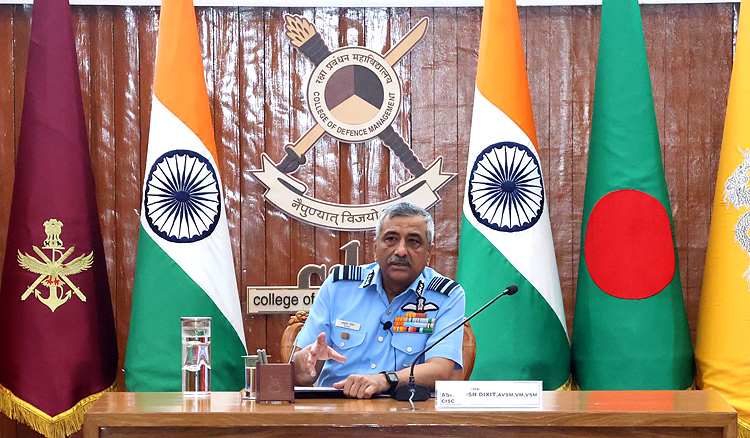
Manish Jha: How does the CISC supervise the coordination of long-range plans, five-year plans, and annual budgetary proposals of the Services?
Dixit: Formulation of Long-Range Plans, earlier referred to as the Long-Term Integrated Perspective Plans (LTIPP), is now being prepared as the Integrated Capability Development Plan (ICDP) by HQ IDS mandated as per the Defence Acquisition Procedure (DAP) 2020. The planning process evolves from the National Security Strategy/Guidelines and the Defence Minister's Operational Directives. ICDP, which is under preparation at HQ IDS, will be a comprehensive 10-year modernisation plan of the Services, and will comprise two five-year Defence Capital Acquisition Plans.
To synchronise the modernisation plans with concurrent technology development by the Industry, a Technology Perspective and Capability Roadmap (TPCR) 2025, prepared by HQ IDS, has recently been approved by the Defence Minister and promulgated to the environment.
Integrated Capability Development Plan (ICDP), which is under preparation at HQ IDS, will be a comprehensive 10-year modernisation plan of the Services, and will comprise two five-year Defence Capital Acquisition Plans
Services' Capital Acquisition Plans are approved every year by the Defence Procurement Board (DPB) through the Annual Acquisition Plans (AAP) prepared by HQ IDS in consultation with Services. The AAP synchronises the annual budgetary outlay allocated by the MoD with current Acquisition Plans. This is a consultative and iterative process, coordinated by HQ IDS, which enables the fruition of planned capital acquisitions of the Services.
Manish Jha: The Capital Budget - 26 per cent of the Defence Budget remains insufficient for military modernisation. How do you ensure the allocation amongst the Services for the continuity of modernisation?
Dixit: Allotment for Capital Modernisation for FY 2025-26 has seen a 5.7 per cent increase from the BE allotment for FY 2024-25, but a 14.4 per cent increase over the RE of FY 2024-25.
This year, the Capital Budget for Modernisation forms approximately 22 per cent of the Defence Budget. Trends of previous years indicate that adequate funds were, and will be, made available for Defence Modernisation.
we have identified key initiatives such as Joint Staff Training (Purple Division) at DSSC Wellington, joint training programmes at various Joint Service Training Institutes and cross postings amongst the services to further the integration process
In fact, based on the Defence Minister's directions during the last Joint Commanders' Conference, we have tentatively worked out the requirement of funds for Capital Modernisation for the next 10 years. Since the Annual Budget (Defence Budget) mandates approval of the Parliament as per the Constitution, the Service continues to plan and undertake its acquisition processes as per the AAP in accordance with the Annual Capital Outlay allocated by MoD (Fin). Reappropriation/allocation of budget, if necessitated towards the end of the FY, is undertaken by the MoD (Finance).
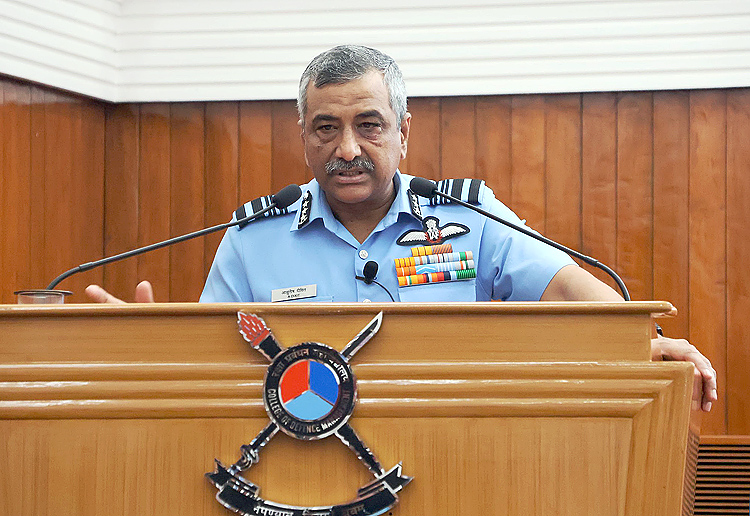
Manish Jha: As an apex military institution, how do you look at the warfare and capability roadmap? How do you look at critical gaps, for example, the depletion squadron for the IAF, the long-delayed process for Submarine Acquisition (P-75I), etc?
Dixit: The changing character of Warfare drives and dictates the Capability Development roadmap. At HQ IDS and the Services, we are seized of the constantly evolving character of warfare and have adjusted our modernisation plans accordingly.
The focus of our capability development now incorporates R&D acquisition of new generation equipment and weapons, driven and connected through seamless integrated networks across Services. The effectiveness of such weapons and platforms was evident in Op SINDOOR, where seamless integration and Jointness in planning and execution were apparent.
It is a complex endeavour involving multiple stakeholders with focus on building consensus and ensuring that when implemented, it achieves jointness and operational efficiency
However, it has been rightly brought out that there are some critical gaps in our capability, especially in large platforms and weapons. The Services have constantly highlighted these to the MoD, and I can assure you that everyone in the MoD is seized of the matter, and all efforts toward mitigation are being undertaken.
Manish Jha: Each Service has a different acquisition plan and process. While complex in terms of Jointness and requirements, how do you optimise the acquisition process and define qualitative elements?
Dixit: The core tasking of each Service necessitates a tailor-made modernisation plan, which is integrated and optimised at HQ IDS to undertake optimisation. Multiple ORSA studies have been undertaken, namely Anti-Tank weapon & Attack Helicopters. However, the acquisition process for all Services remains the DAP 2020. Presently, the process being used for integration and optimisation of the modernisation plans is the Integrated Capability Development System (ICADS), from which the ICDP will eventually flow. The ICADS uses a threat cum Capability model to prioritise and optimise capability requirements based on National Military Objectives and Derived Military Missions.
The integrated plans, which will take into account all contingencies and scenarios, will then be processed through the DAP-20 (or the next iteration of OAP), manifesting into capability acquisitions.
Manish Jha: As per the mandate, how do you look at progress on building a theatre command? Is there a timeline?
Dixit: The process of theaterisation is being approached in a calibrated and deliberate manner. A lot of work has been done in terms of studies, consultations, and planning to ensure that the final structure is both effective and sustainable. It is a complex endeavour involving multiple stakeholders with focus on building consensus and ensuring that when implemented, it achieves jointness and operational efficiency.
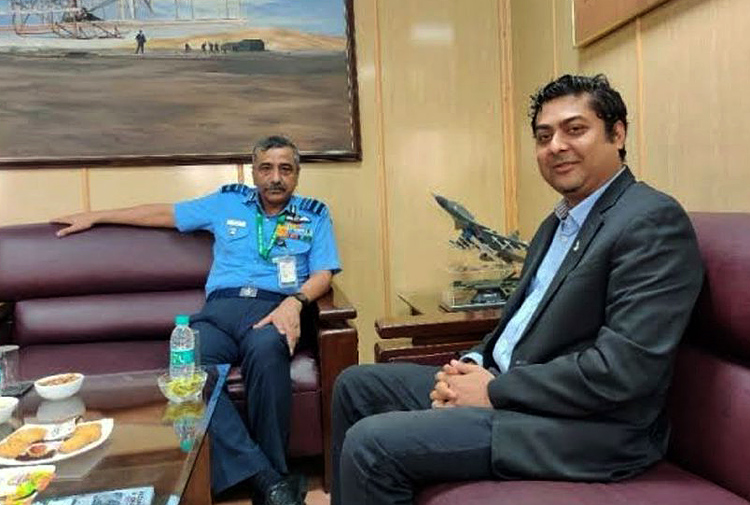
Manish Jha: Could also talk about CISC's role in laying guidelines for indigenisation of military platforms, systems, and R&D in the military?
Dixit: • R&D in the Military: The government has mandated spending of 25 per cent of the Defence R&D Budget on the private sector. This is being progressed through schemes such as TDF, iDEX and incorporating Private vendors in Design and Development projects of DRDO (for example L&T for Zorawar).
TDF scheme, which aims to build a strong defence industrial base through in-house design and development, has been enhanced to ₹50 crore from ₹10 crore. As a member of the empowered committee of the TDF, the CISC is actively involved in granting access to projects involving start ups and MSMEs.
- Creation of CoE: Centres of Excellence on diverse subjects related to defence technology have been created with the Academia, such as IITs, by DRDO. Amongst the Services too, institutes such as UDAAN & MCTE are designated as CoE for AI & Quantum Communications.
- Emphasis on ToT: Greater emphasis is now being placed on Transfer of Technology in all procurement deals with global vendors. This is aimed at developing the required expertise in own private sector. Case in point, being the Multi-Role Fighter Aircraft project.
- M.Tech in Def Tech: Private universities/ Colleges have now started offering M.Tech in defence technologies for students pursuing higher studies. This will enable absorption of home-grown talent by the own private industry. Further, incubation cells for progressing R&D have been created at institutes such as IISc Bangalore & IIT Madras.
Manish Jha: What is the role of CISC in laying guidelines for Indigenisation?
Dixit: The HQ IDS under the CISC is tasked with promoting and overseeing the indigenisation of defence equipment and stores. It ensures implementation of the positive Indigenisation list, which identifies Defence items and technologies to be progressively sourced from Indian manufacturers.
For the Indigenisation. the CISC's role in laying guidelines for Indigenisation encompasses coordinating tri-service requirements and creating a unified strategic outlook for indigenous platform development. Crucially, the role acts as a nodal point for commonality and interoperability between the services and the Indian Coast Guard.
The integrated plans, which will take into account all contingencies and scenarios, will then be processed through the DAP-20 (or the next iteration of OAP), manifesting into capability acquisitions
Primarily, it does play a role in the formulation of a roadmap for indigenisation of ammunition, radars and tanks. Additionally, CISC encourages, facilitates, and guides the industry to meet present and future requirements of the armed forces and carry out necessary handholding. While doing so, it seeks inputs from stakeholders and takes up in relevant forums for policy reforms.
Conceptualise and prepare web web-based application hosting a list of Indian private vendors to enhance the visibility of all the available dealers to the Indian Armed Forces.
Management of the EM spectrum. is an important activity that requires prospective planning and coordination at the National & International levels. The salient aspects of this activity are as follows:
- Coordinate, liaise and facilitate harmonised allocation of spectrum among the Tri Services, DRDO & SFC, including maintenance of a spectrum management system (e-tarang) for dynamic and efficient allocation of spectrum among the three Services.
- Safeguarding defence spectrum interest in various national & International forums/meetings in coord with WPC, DoT. All Tri Services spectrum issues are effectively addressed through the apex body, i.e. Jt Electro Magnetic Board (JEMB), which is one of the COSC sub-committees.
- Act as the spectrum administrator for handling of Standing Advisory Committee on Frequency Allocation (SACFA) for the Tri Services.
Network Centric Warfare (NCW). is a 'Concept of Operation' in which all surveillance assets, intelligence inputs, troops, weapon systems, Logistic inputs, decision-making systems, etc, are networked to achieve greater awareness of own and the enemy's assets on the battlefield.
NCW speeds up the Information-Decision-Action (IDA) cycle and leads to compression of time (speedier actions) and expansion of space (larger coverage). The main advantage of NCW lies in faster decision-making, greater effectiveness of weapons, higher survivability of own forces, greater operational autonomy for geographically dispersed military forces, and, in general, higher tempo in the conduct of operations through shortening of the OODA loop.
Multi-platform Multi-sensor Data Fusion is a use case of NCW wherein the aggregation of information (data fusion/correlation) from multiple sensors of different vintage and located on different platforms was challenging but made feasible through technological advancements. This correlated and fused picture would be available as a Common Operating and Intelligence picture. In NCW, enhanced situational awareness would result in a larger 'Engagement Envelope' with lower risks, better manoeuvrability, and enhanced kill probabilities.
CISC's role in laying guidelines for Indigenisation encompasses coordinating tri-service requirements and creating a unified strategic outlook for indigenous platform development
Manish Jha: Could you elaborate on the engagements and contributions of CISC in international engagements to foster regional security and cooperative solutions with other nations?
Dixit: India's global stature is rising, and so are our global defence engagements. We, at HQ IDS, are responsible for coordinating various defence cooperation activities with friendly foreign countries, which include HADR missions and Training Cooperation (both individual and collective training). It also includes Joint military exercises with more than 38 countries and capacity building of the armed forces of Friendly Foreign Countries (FFCs) in terms of organisational support, training teams, defence exports and equipment repair and maintenance support.
Our global footprint has increased substantially in the last few years, with the establishment of additional defence wings all across the globe, especially in Africa, Latin America, and the Indian Ocean Region. We regularly participate in high-level International geo-strategic military forums such as the Indo-Pacific Chiefs of Defence Conference, the Indo-Pacific Intelligence Chiefs Conference, the Shangri-La Dialogue, and the Manama Dialogue. At CISC, I am also the chair of high-level interaction mechanisms with FFCs, on behalf of the three services.
Lastly, we have come to be accepted as a "First Responder" and a "Preferred Security Partner", especially after recent Humanitarian Assistance and Disaster Relief (HADR) missions carried out by our Armed Forces in support of Friendly Foreign Countries (FFCs).
Manish Kumar Jha is a Consulting & Contributing Editor for SP's Aviation, SP's Land Forces and SP's Naval Forces and a security expert. He writes on national security, military technology, strategic affairs & policies.




